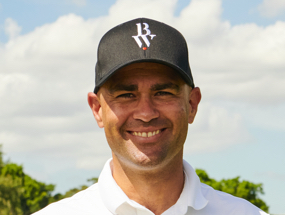In golf, nothing is more fundamentally important than the grip. Our grip provides the only connection to the club, which is the only thing contacting the ball. An incorrect grip can lead to a host of problems in your golf game.
In this blog, we discuss tips on how to create a neutral golf grip, along with an explanation of the different types of golf grips and grip strengths.
Why the Grip Is Important
The way you position your fingers on the grip of the club has a significant effect on the path the club will take as it passes your body. This path dictates the flight and direction of the golf ball.
Although a proper golf swing often overlooks the importance of a good golf grip, serious golfers should pay careful attention to where they position their hands on the grip before every single shot.
- Creates mobility
- Generates power
- Facilitates rotation
- Creates the proper hinging motion
- Helps promote consistency
- Creates the right amount of leverage in a golf swing
Types of Golf Grips
There are typically three types of golf grips, each with its own advantages and disadvantages:
- Overlap Grip (Vardon)
- Interlock Grip
- Baseball Grip (10 Finger)
Here, we’ll explain the Overlap Grip (Vardon), Interlocking Grip, and Baseball Grip (10 Finger) grips, along with who each type of golf grip is best for:
-
Vardon Grip – Overlap Grip
The Vardon grip is the most common golf grip in the world, used by 90% of Tour players and the vast majority of golfing amateurs. Named after Harry Vardon, the British golfer who popularised this grip, it involves both hands anchored through the right pinky finger. The right pinky then lies on top of the depression between the index and middle fingers of the left hand.
The Vardon grip is most commonly used by adults with strong hands and long fingers since the fingers are needed to overlap and act as a solid anchor. If your pinkie is too short or weak, you risk having your hands slip out of position during your golf swing.
-
Interlock Grip
The second most common golf grip is the Interlock Grip. This type of grip connects the hands to each other by the pinkie finger on the right hand and index finger on the left hand.
However, rather than sitting on top of each other, the fingers cross in the interlocking grip. This position works to secure the hands close together and lock the grip in place.
This grip is common for smaller hands and fingers, women, and famous golfers such as Tiger Wood and Jack Nicklaus.
-
Interlock Grip
The second most common golf grip is the Interlock Grip. This type of grip connects the hands to each other by the pinkie finger on the right hand and index finger on the left hand.
However, rather than sitting on top of each other, the fingers cross in the interlocking grip. This position works to secure the hands close together and lock the grip in place.
This grip is common for smaller hands and fingers, women, and famous golfers such as Tiger Wood and Jack Nicklaus.
Types of Grip Strength
Along with grip types, it is important to consider grip strengths. Grip strength refers to the way you place your hands on the grip, not how tightly you hold the club.
Grip strength has a significant effect on your swing and can greatly improve your golf game once you perfect it.
The three types of grip strength are:
- Neutral
- Weak
- Strong
Here, we’ll look at the various grip strengths and the different effects they produce on your golf swing:
Relative Strength
The relative strength is the way the fingers are positioned according to the centre of the grip. A neutral grip involves fingers placed in the middle, to the left is a weak grip, and slightly to the right is a strong grip.
For all of the grip strengths, both palms should be facing each other on opposite sides of your grip.
-
Neutral Grip
- What Is a Neutral Grip — A neutral grip refers to both hands around the centre and on top of the grip, not to either side. This is an important grip to master and will help you achieve more consistency in your golf game.
- How to Place Your Fingers — Grip the club using your left hand, keeping the clubface square to your target. You should see only two knuckles when you look down (your middle finger and index finger).
With your left hand secured, place the right hand opposite of it and below it. If done correctly, your thumbs and index fingers should form a V shape and point to your nose (slightly to the right of it).
-
What a Neutral Grip Promotes — A neutral grip doesn’t favour either side. Rather, it promotes a straight ball flight. When used with a proper swing, a neutral grip will tend to reach back upon impact in a square position.
-
Strong Grip
- What Is a Strong Grip — When looking down, a strong grip involves both hands slightly offset to the right of your grip as opposed to being in the centre of the shaft.
- How to Place Your Fingers — Grip the club using your left hand, ensuring the clubface is square to your target. You should see three knuckles: your ring, middle, and index fingers.
With your left hand positioned, place your right hand opposite of it and below, with both palms facing each other. When completed correctly, your index fingers and thumbs should form a V shape that points slightly toward your right shoulder.
-
What It Promotes — A strong grip promotes the active release of the hands upon impact. By encouraging the hands to roll into the impact, this grip favours a more closed clubface that may result in a ball that will hook or draw.
-
Weak Grip
- What Is A Weak Grip — A weak grip involves both hands positioned slightly to the left of the centre of the grip.
- How to Place Your Fingers — Grip the club with your left hand and ensure the clubface is square to your target. You should only see one knuckle — your index finger — when you look down at your hands.
Once you have your left hand firmly positioned, place your right hand opposite of it and below it so the palms are facing together. If done correctly, your index fingers and thumbs should form a V shape that points slightly toward your left shoulder.
- What a Weak Grip Promotes — A weak grip prevents the hands from fully rolling into impact. This leads to a clubface that is more open at impact and can result in a ball that will slice or face.
Troubleshooting Your Golf Grip
Even if you work on your grip as much as possible, you may still experience some issues.
Here, we’ll cover Frequently Asked Questions about Golf Grips and common golf grip problems, and how to correct grip mistakes.
What happens if my golf grip is too tight?
If you grip the club too tightly, it can create tension in the shoulders and forearms and prevent you from generating maximum club head speed. This will result in less power and reduced shot distance.
What is wrong with my golf grip?
If you are failing to get the ball very far into the air and it is driving low and to the left, it is likely that you have your right hand turned too much underneath the club.
How much pressure should a golf grip have?
Imagine you are holding a tube of toothpaste firm enough to grasp it, but not so tightly that you squeeze any toothpaste out of it. This translates to roughly a four, perhaps a five, on a scale of 1 to 10.
Can grip size affect golf swing?
Yes, grip size affects how low or high you hit the ball. Too small of a grip forces you to squeeze too much and leads to limited wrist mobility. Too big of a grip makes it more difficult to keep the clubface square at impact. To become a more consistent golfer, finding the right grip size is key.
What happens if my golf grip is too strong?
Do you hook the ball to the left often? This is often a sign of a grip that is too strong. If you are hooking to the left, try adjusting your left hand slightly to the left until you achieve a weaker position.
Which grip type should I use?
The most important part of choosing a grip type? Comfort. Your hands and fingers need to feel comfortable, secure, and have the right balance of pressure without feeling tense, uncomfortable, or strained.
Feel free to experiment with different grips to see which works best for you. Often, it is a good idea to start by trying the most popular grip (Overlap Grip) and moving on from there until you find the best golf grip for you.
Why am I losing power in my swing?
Losing power in your swing is commonly experienced by golfers who have made changes to their grip. If you have recently tried a new grip, you may be holding the club tighter to offset any awkwardness you are feeling due to the new position of your hands.
If you are suddenly unable to hit the ball as far as you used to, pay attention to how tightly you are gripping the club and any recent changes you have made to your grip.
Want More Golfing Tips, Instructional Golf Videos, or Online Golf Coaching?
We hope you found our guide to golf club grips helpful. For a guide to putter grip size and style, check out this blog.
If you would like more golf tips, golf lessons, free instructional golf videos, or online coaching, please contact me with any questions or to sign up for a course.


